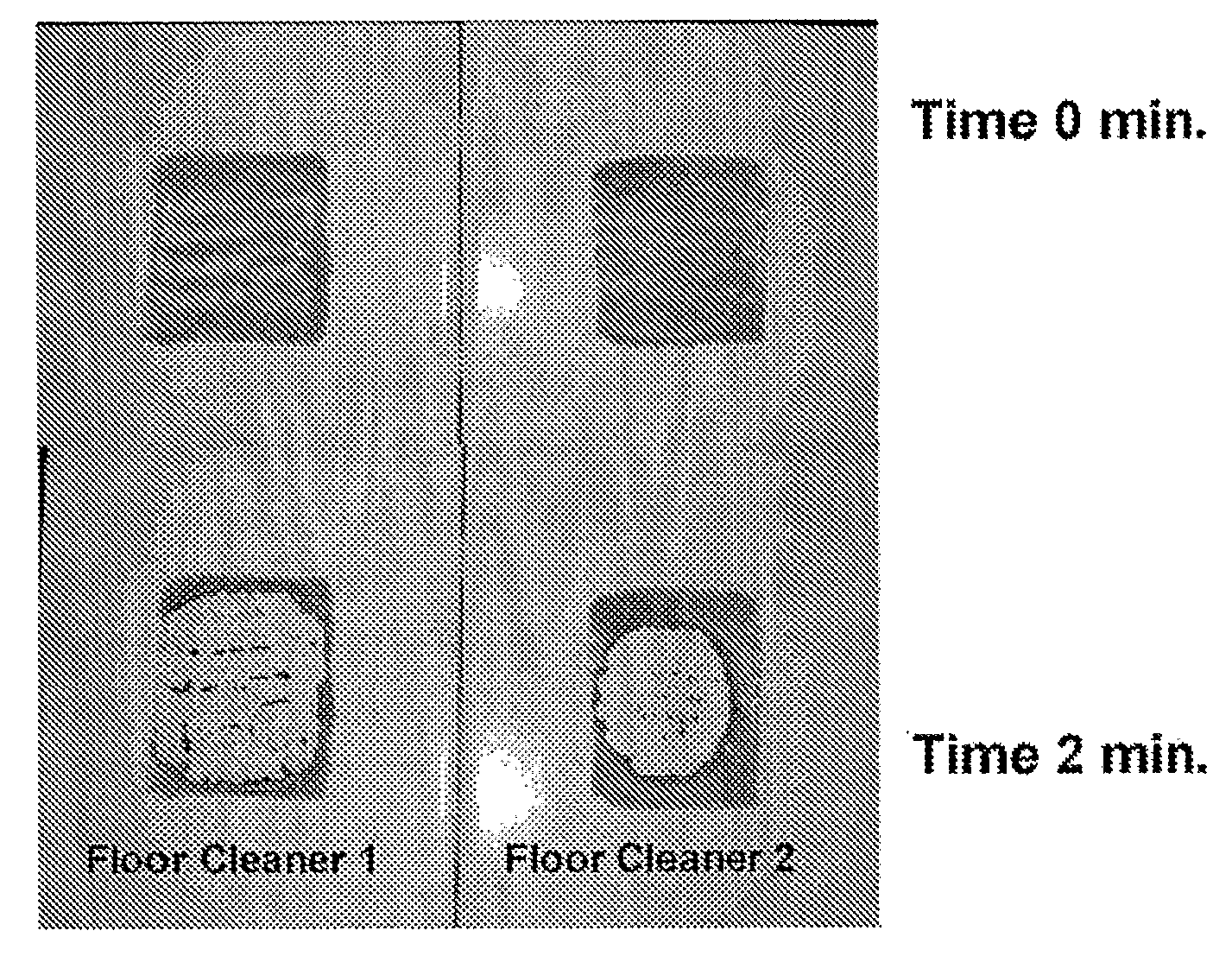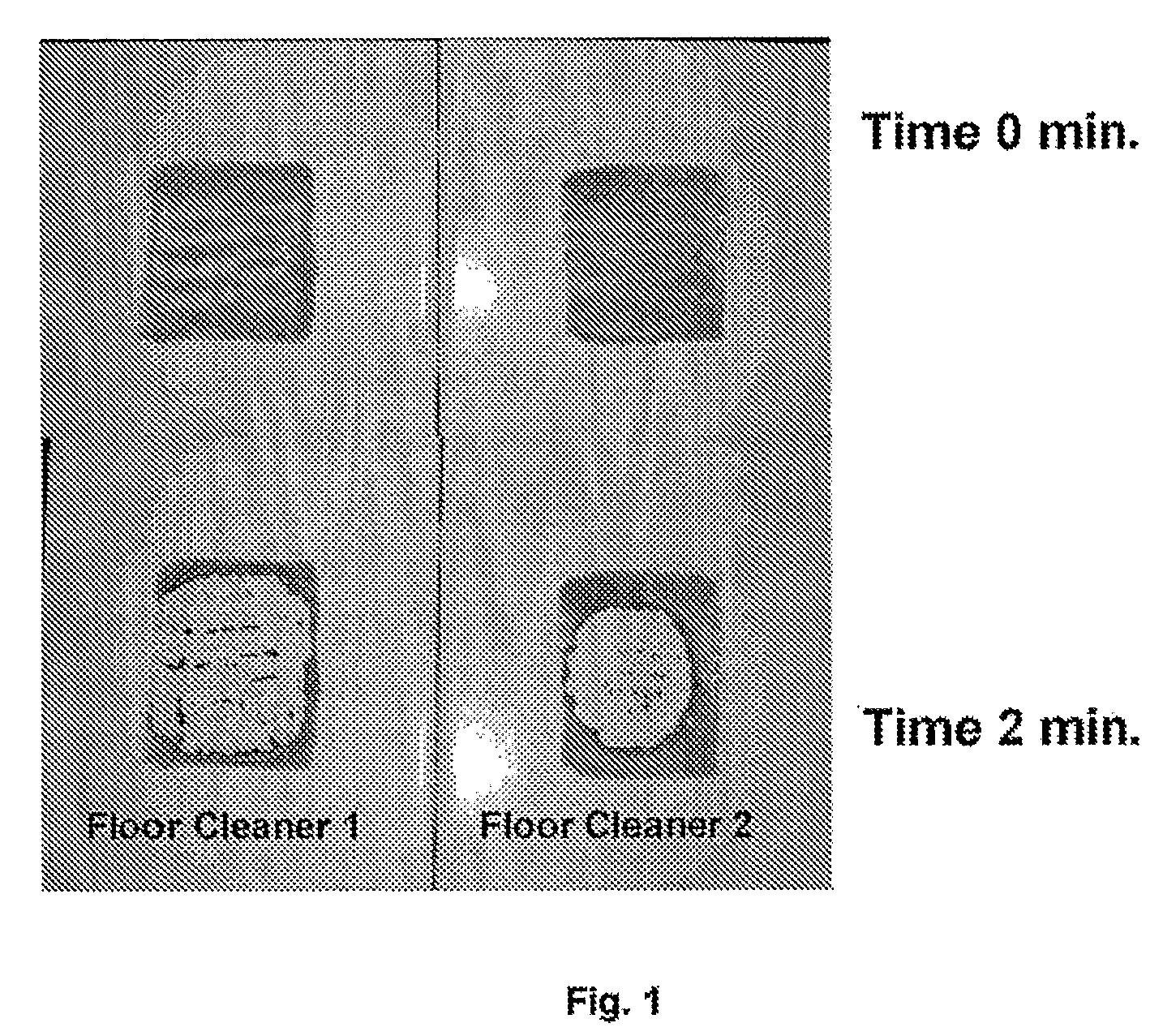Surfactant Systems for Surface Cleaning
a surfactant system and surface cleaning technology, applied in the field of surfactant systems, can solve the problems of undesirable organic solvents in cleaning compositions reduce the size of surfactant molecules, reduce the time required, and reduce the solubility of the surfactant system
- Summary
- Abstract
- Description
- Claims
- Application Information
AI Technical Summary
Benefits of technology
Problems solved by technology
Method used
Image
Examples
example 1
Preparation of a Carpet Spot Remover
[0118]The following surfactant systems were prepared. In each formulation, the active Sodium Octyl Sulfonate is introduced as BIO-TERGE® PAS-8S (Stepan Company), which is a solution containing 37.8% active Sodium Octyl Sulfonate. In the following examples where Sodium Octyl Sulfonate is used, the quantity of Sodium Octyl Sulfonate is given as percent actives.
A. Anionic Surfactant and Nonionic Surfactant in a Ratio of about 6:1 (Formulation A).
[0119]This formulation is a starting formulation to be used as active cleaning base in a carpet spot remover.
% ByMaterialWeightFunctionWaterQ.S.Solvent for all other materialsSodium Octyl1.28Water soluble anionic surfactant,Sulfonateallows powdery residueTomadol 91-60.23Water soluble nonionic surfactantIsopropyl2.50Organic solvent to help with water-Alcoholinsoluble stain removalKathon0.050PreservativeCG / ICPBronopol0.025Preservative(BIOBAN ™BP-PLUS)Citric Acid0.25Provide buffering pH 6-7Caustic Soda0.30pH adj...
example 2
Caret Extraction Cleaner
[0148]An aqueous cleaning composition for use in carpet extraction cleaning was prepared as described below. The cleaning compositions illustrate products that the consumer purchases and dilutes in water by adding 2 ounces (56.7 grams) to the filling tank and filling with hot water to make a total of one gallon (3.79 liters).
[0149]The objective is to minimize the solubility of the surfactant system for in-use cleaning compositions at hot water temperatures in the range from 60-70° C. Typically, the highest in-use temperature would be about 150° F. (65.6° C.). The non-diluted original surfactant system or original cleaning composition should be phase stabile from 5° C. to 45° C.
[0150]Five original cleaning composition formulations were prepared, and the compositions, as weight / weight percentages, are given in Table 1 below. The ratio of Tomadol 91-6 to Tomadol 91-2.5 is also given as a percentage ratio of the total content of Tomadol 91-6 and Tomadol 91-2.5. N...
examples 3
Preparation of Concrete Cleaner (3× Concentrate) with Salt
1. Concrete Cleaner 3× Concentrate
[0153]A concrete cleaner, KNKE 59, was prepared so that the concentration of surfactants was 3-times higher that the in-use concentration. The formulation is given below in Table 3. This formulation had a pH of 8.92, and was found to be stable from freeze-thaw to at least 45° C. The strategy was to minimize the solubility of the 1:2 dilutions so that the performance of the 1:2 dilutions was maximized.
[0154]In Table 3 below, Dodecyl Benzene Sulfonic Acid is given as the actual quantity of BIO-SOFT® S-101 (Stepan Company) added, which is 96% active. It was neutralized, or converted to the sodium salt (anionic form), by the addition of sodium hydroxide.
TABLE 3Concrete Cleaner 3X Concentrate, KNKE 59% wt. / wt.Dodecyl Benzene Sulfonic Acid5.14Tomadol 91-644.44EDTA (40%)2.40Urea2.40Nipacide BIT 200.30Sodium Bicarbonate0.45Sodium Carbonate0.05WaterQ.S.
2. Dilutions of Concrete Cleaner 3× Concentrate
[0...
PUM
| Property | Measurement | Unit |
|---|---|---|
| temperatures | aaaaa | aaaaa |
| pH | aaaaa | aaaaa |
| pH | aaaaa | aaaaa |
Abstract
Description
Claims
Application Information
 Login to View More
Login to View More - R&D
- Intellectual Property
- Life Sciences
- Materials
- Tech Scout
- Unparalleled Data Quality
- Higher Quality Content
- 60% Fewer Hallucinations
Browse by: Latest US Patents, China's latest patents, Technical Efficacy Thesaurus, Application Domain, Technology Topic, Popular Technical Reports.
© 2025 PatSnap. All rights reserved.Legal|Privacy policy|Modern Slavery Act Transparency Statement|Sitemap|About US| Contact US: help@patsnap.com


